Heating pipes as a way to protect communications from
Very often, when laying communications in the private sector, it is impossible to lay pipes below the freezing point due to a number of reasons, and when the temperature drops to low values, the probability of the water supply and sewage freezing is high. There are several options for how to secure your system: heating pipes from the inside or outside using a cable or tape.
It all depends on the characteristics of communications and the required power.
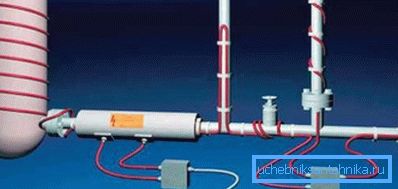
What is heating done for?
Creating a system for maintaining a certain temperature in communications can perform several important tasks:
| Prevent freezing of fluid in the system | Without a doubt, this reason is one of the most common and important, since in the main part of the country’s territory during the winter period the thermometer may drop to very low values, and to remain without water and sewage in such a period is highly undesirable. |
| Heat loss compensation | In some systems, it is very important that the temperature of the fluid at the inlet and outlet of the pipe is the same, and with the help of heating this is very easy to achieve, because you can compensate for heat loss |
| Fluid heating | Sometimes it is important to maintain a constant temperature in the system, regardless of external conditions. At the same time, the power reserve of the system must be sufficiently high in case of heat absorption during operation. |
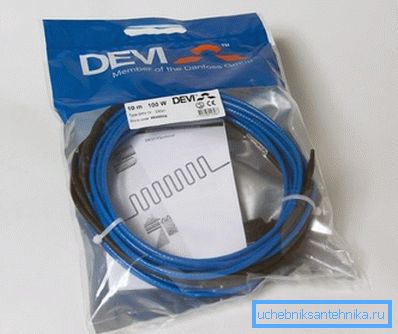
Types of heating
Let us consider the main options with which you can protect your pipes, there are not many of them, but each of them has its own characteristics that you need to know about in order to make the right and informed choice.
Outdoor heating
One of the most common options for several reasons:
- The low price of wires and components, which is especially important for large volumes, because even the most budgetary options will require quite a significant investment.
- The simplicity of the work allows you to carry out all the necessary activities with your own hands without attracting qualified specialists, whose services are also quite expensive.
- Sufficiently high efficiency in compliance with all required installation conditions.
To lay a thermal pipe for heating the pipes in the following ways:
- A straight line along the whole pipe, and this can be one or several cables, it all depends on the diameter of the communications and the required characteristics.
- Wavy line laying to increase the heating area without laying several wires.
- Wrapping the entire diameter of the pipe in the form of a spiral allows for uniform heating of the entire pipe and is suitable for areas with very low temperatures, but, accordingly, the consumption of materials also increases significantly.
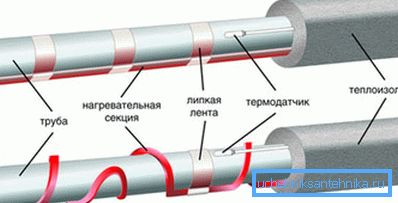
The workflow is as follows:
- First, the cable is laid in any of the above methods.
- Next, a temperature sensor is installed to control the temperature, and all elements are fixed with adhesive tape so that their position remains unchanged.
- It is important to make a reliable connection of the installation wire so that the cord for heating the pipes is well connected and tight, it is best to use a heat shrink tube.
- Then everything is closed with special insulation, the easiest way is to purchase it in finished form and put it on the pipe.
Remember! Outside, it is desirable to make a protective shell, it will protect the system from damage and prevent heat loss.
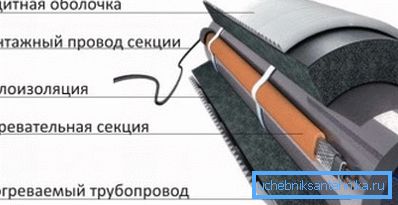
Sometimes an electric tape is used to heat pipes, it resembles a wire, but due to the greater width, its power is much higher.
Internal heating
This option is also widely distributed, especially popular is the heating of sewage pipes from the inside, as they have a large diameter, and it is quite convenient to carry out work.
The features of this option include the following factors:
- The shell of the product must be made of food-grade polyethylene, which is resistant to aggressive chemical compounds. In addition, when used in plumbing systems such wires do not emit any harmful substances.
- The cable has high rigidity, which simplifies its installation in the system.
- It is very important to remember that the heating parts of the wire should not be bent, therefore measurements of all straight sections should be made very carefully, it is also important to tightly protect all connections with heat shrinkable tubes.
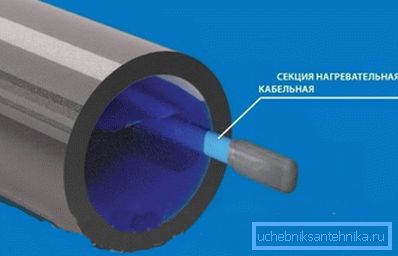
Tip! It is important that the products comply with all regulatory requirements, so be sure to ask the seller for quality and hygienic safety certificates.
Self-regulating wire
This option has appeared recently, but its effectiveness is significantly higher due to the following properties:
- The wire itself regulates the heat transfer depending on the temperature and in different areas can give a different amount of heat.
- Installation instructions are very simple: a piece of the right size is cut, to which the power cord is attached. And the length can be any: at least one, at least a hundred meters.
- The wire is installed on the outside of the communications, its installation is no different from that described above.
The use of self-regulating wires can significantly reduce the cost of electricity, which is important in the face of rising energy prices.
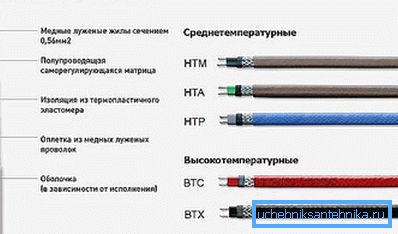
Conclusion
The use of heating systems allows you to protect water supply and sewage even from the most severe frosts. The video in this article will tell you more about some important points of the topic we have studied so that you can independently make effective heating of pipes.